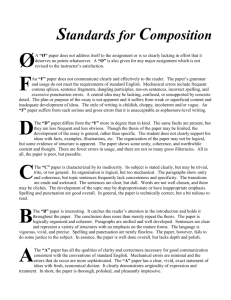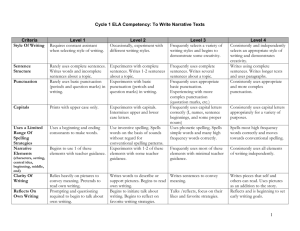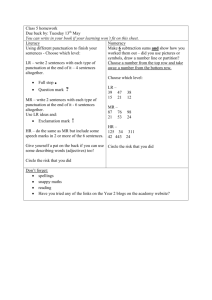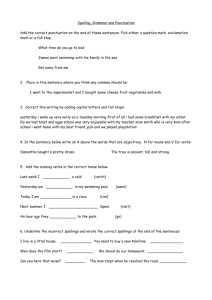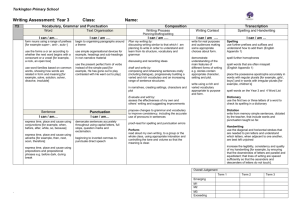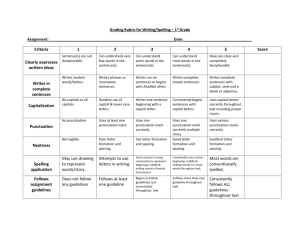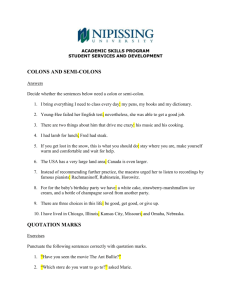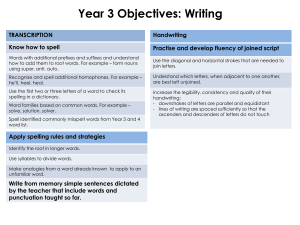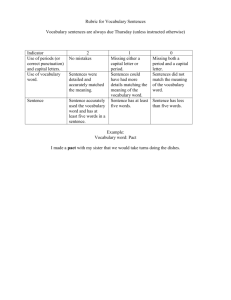1st grade writing rubric 6-t
advertisement
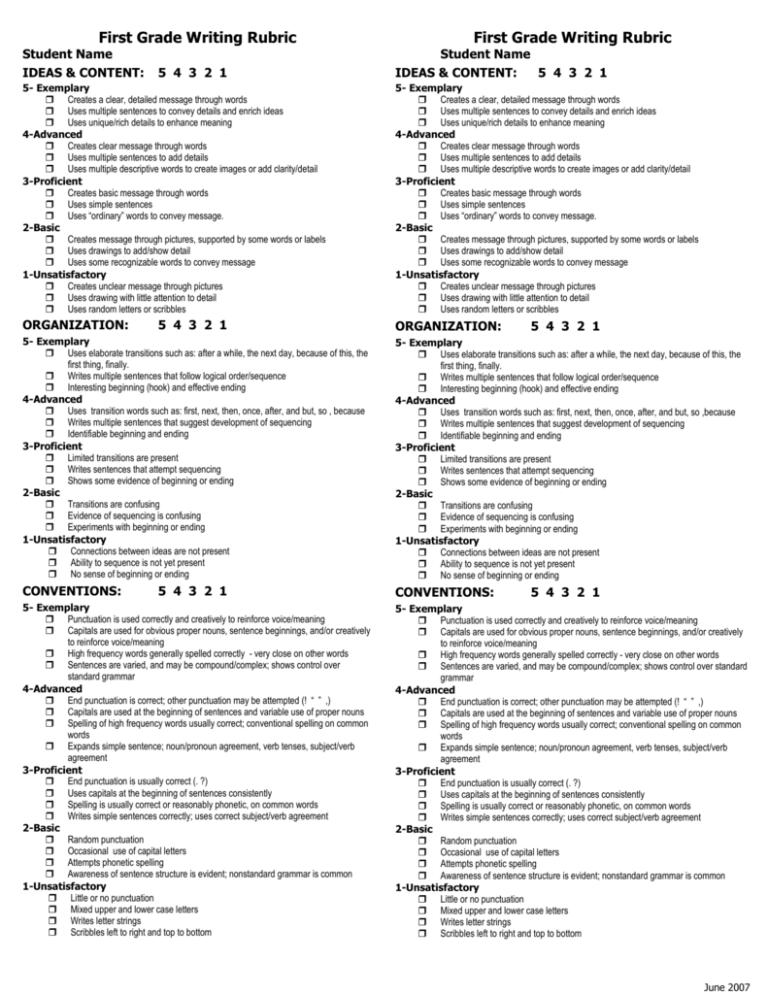
First Grade Writing Rubric Student Name IDEAS & CONTENT: 5 4 3 2 1 First Grade Writing Rubric Student Name IDEAS & CONTENT: 5 4 3 2 1 5- Exemplary Creates a clear, detailed message through words Uses multiple sentences to convey details and enrich ideas Uses unique/rich details to enhance meaning 4-Advanced Creates clear message through words Uses multiple sentences to add details Uses multiple descriptive words to create images or add clarity/detail 3-Proficient Creates basic message through words Uses simple sentences Uses “ordinary” words to convey message. 2-Basic Creates message through pictures, supported by some words or labels Uses drawings to add/show detail Uses some recognizable words to convey message 1-Unsatisfactory Creates unclear message through pictures Uses drawing with little attention to detail Uses random letters or scribbles 5- Exemplary Creates a clear, detailed message through words Uses multiple sentences to convey details and enrich ideas Uses unique/rich details to enhance meaning 4-Advanced Creates clear message through words Uses multiple sentences to add details Uses multiple descriptive words to create images or add clarity/detail 3-Proficient Creates basic message through words Uses simple sentences Uses “ordinary” words to convey message. 2-Basic Creates message through pictures, supported by some words or labels Uses drawings to add/show detail Uses some recognizable words to convey message 1-Unsatisfactory Creates unclear message through pictures Uses drawing with little attention to detail Uses random letters or scribbles ORGANIZATION: ORGANIZATION: 5 4 3 2 1 5 4 3 2 1 5- Exemplary Uses elaborate transitions such as: after a while, the next day, because of this, the first thing, finally. Writes multiple sentences that follow logical order/sequence Interesting beginning (hook) and effective ending 4-Advanced Uses transition words such as: first, next, then, once, after, and but, so , because Writes multiple sentences that suggest development of sequencing Identifiable beginning and ending 3-Proficient Limited transitions are present Writes sentences that attempt sequencing Shows some evidence of beginning or ending 2-Basic Transitions are confusing Evidence of sequencing is confusing Experiments with beginning or ending 1-Unsatisfactory Connections between ideas are not present Ability to sequence is not yet present No sense of beginning or ending 5- Exemplary Uses elaborate transitions such as: after a while, the next day, because of this, the first thing, finally. Writes multiple sentences that follow logical order/sequence Interesting beginning (hook) and effective ending 4-Advanced Uses transition words such as: first, next, then, once, after, and but, so ,because Writes multiple sentences that suggest development of sequencing Identifiable beginning and ending 3-Proficient Limited transitions are present Writes sentences that attempt sequencing Shows some evidence of beginning or ending 2-Basic Transitions are confusing Evidence of sequencing is confusing Experiments with beginning or ending 1-Unsatisfactory Connections between ideas are not present Ability to sequence is not yet present No sense of beginning or ending CONVENTIONS: CONVENTIONS: 5 4 3 2 1 5- Exemplary Punctuation is used correctly and creatively to reinforce voice/meaning Capitals are used for obvious proper nouns, sentence beginnings, and/or creatively to reinforce voice/meaning High frequency words generally spelled correctly - very close on other words Sentences are varied, and may be compound/complex; shows control over standard grammar 4-Advanced End punctuation is correct; other punctuation may be attempted (! “ ” ,) Capitals are used at the beginning of sentences and variable use of proper nouns Spelling of high frequency words usually correct; conventional spelling on common words Expands simple sentence; noun/pronoun agreement, verb tenses, subject/verb agreement 3-Proficient End punctuation is usually correct (. ?) Uses capitals at the beginning of sentences consistently Spelling is usually correct or reasonably phonetic, on common words Writes simple sentences correctly; uses correct subject/verb agreement 2-Basic Random punctuation Occasional use of capital letters Attempts phonetic spelling Awareness of sentence structure is evident; nonstandard grammar is common 1-Unsatisfactory Little or no punctuation Mixed upper and lower case letters Writes letter strings Scribbles left to right and top to bottom 5 4 3 2 1 5- Exemplary Punctuation is used correctly and creatively to reinforce voice/meaning Capitals are used for obvious proper nouns, sentence beginnings, and/or creatively to reinforce voice/meaning High frequency words generally spelled correctly - very close on other words Sentences are varied, and may be compound/complex; shows control over standard grammar 4-Advanced End punctuation is correct; other punctuation may be attempted (! “ ” ,) Capitals are used at the beginning of sentences and variable use of proper nouns Spelling of high frequency words usually correct; conventional spelling on common words Expands simple sentence; noun/pronoun agreement, verb tenses, subject/verb agreement 3-Proficient End punctuation is usually correct (. ?) Uses capitals at the beginning of sentences consistently Spelling is usually correct or reasonably phonetic, on common words Writes simple sentences correctly; uses correct subject/verb agreement 2-Basic Random punctuation Occasional use of capital letters Attempts phonetic spelling Awareness of sentence structure is evident; nonstandard grammar is common 1-Unsatisfactory Little or no punctuation Mixed upper and lower case letters Writes letter strings Scribbles left to right and top to bottom June 2007
